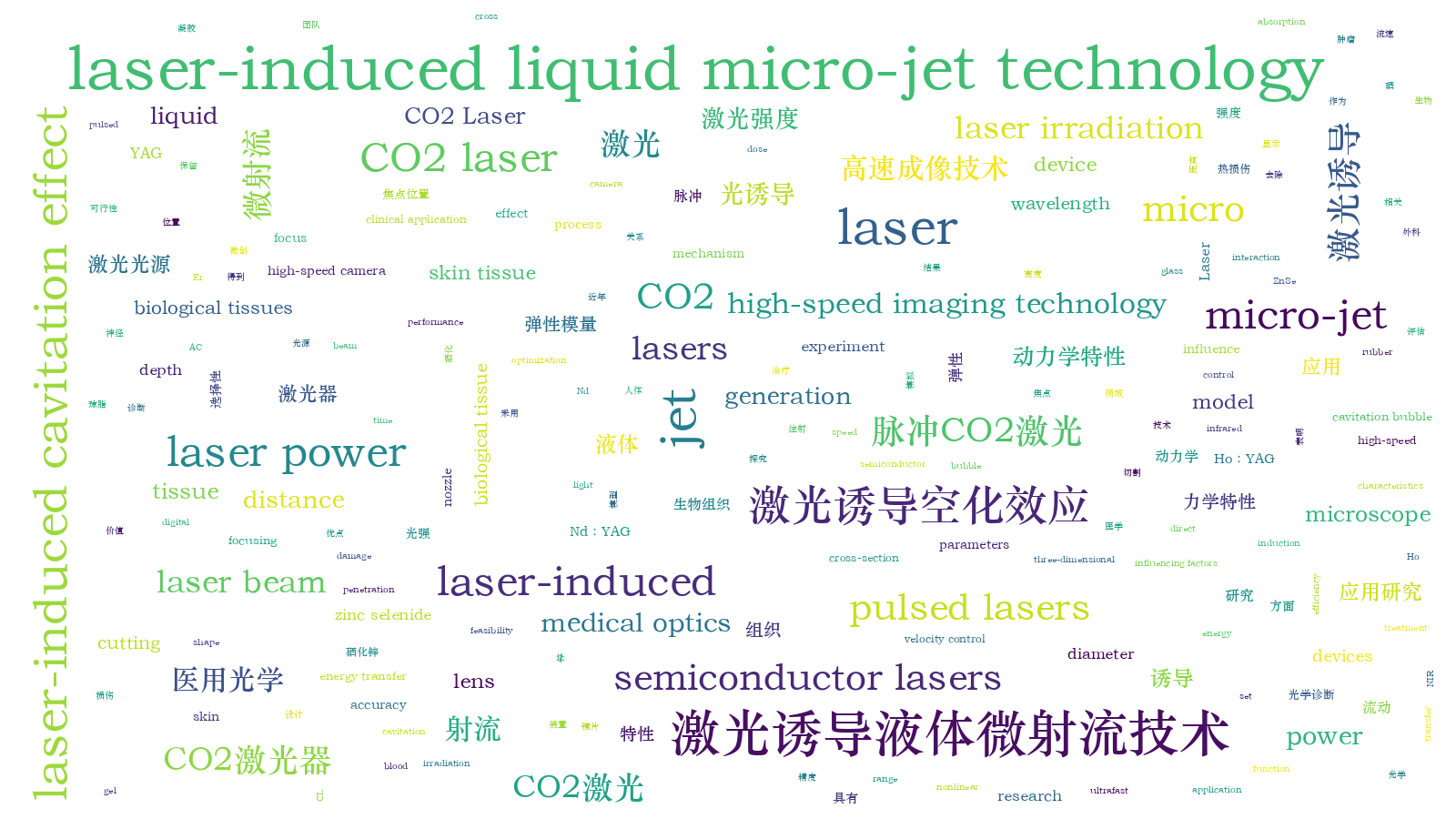脉冲CO2激光诱导液体微射流动力学特性及应用研究
Currently, liquid micro-jet systems induced by pulsed lasers have been applied in surgery, which not only has the anatomical function of the traditional scalpel, but also has the characteristics of intact preservation of blood vessels. It has been used in the treatment of various organs and has rapidly developed. The laser sources of laser-induced micro?jet devices are mainly Er∶YAG, Nd∶YAG, Ho∶YAG and near-infrared (NIR) semiconductor lasers. Most jet emitters use rubber cortices for the energy transfer. However, the efficiency of the jet generated by these devices is low. According to the latest research on a 10.6 μm CO2 laser, the wavelength of the laser is close to the absorption wavelength of water, and the laser can be coupled with a zinc selenide lens, which has better performance for generating micro-jets and greatly improves the probability of jet generation. However, there are no reports on the liquid micro?jet device induced by this wavelength laser, and the influencing factors of the micro?jet generated by this wavelength laser have rarely been studied. Therefore, we designed a 10.6 μm CO2 laser-induced liquid micro-jet device, elaborated the mechanism of laser-induced micro?jet generation, explored the influence of liquid parameters and light dose parameters on laser-induced micro?jet generation, and evaluated the feasibility of the device technology for tissue-selective cutting and other aspects.
In this experiment, a 10.6 μm CO2 laser was used as the induction device for the laser-induced jet (laser power P was set to 18-25 W). Quartz glass with a length of 2 cm, cross-section diameter of 1 cm, and conical angle of 14° at the lower end was used as the jet generation chamber, and the laser beam was focused to a point in the generation chamber through a ZnSe focusing lens. In addition, in this experiment, the distance D between the laser focus and zinc selenide lens and the distance S between the nozzle and model were varied from 3 mm to 12 mm. A high-speed camera was combined with a prime lens and a digital microscope to carry out systematic research on the generation of laser-induced jets, interaction with biomimetic biological tissue, penetration depth and other three-dimensional spatial changes, and corresponding ultrafast process.
In the experiment, we observed four different jet shapes: column (CL), mushroom (MS), needle (AC), and turbulent (TS) [Fig. 3(a)-(d)]. The turbulent and needle jet velocities can reach 44.17 and 53.31 m/s, respectively[Fig. 4(a)]. The experimental results show that the diameter of the jet tip is typically in the range of 40-100 μm, and the diameter of the thicker part is usually 600-750 μm [Fig. 4(b)]. When D is fixed at 3 mm and the incident laser power P (18-25 W) is changed, the jet velocity increases monotonically with increasing laser power. The jet velocity can be fine-tuned from 10 to 50 m/s by adjusting only the incident laser power [Fig. 5(a)]. However, when the laser power is fixed (P=20 W) and D=3-7 mm, the jet velocity increases monotonically in a nonlinear form with an increase in the distance D [Fig. 5(b)], and when S is 4 mm, the depth of the hole formed is the largest [Fig. 6(c)]. In addition, under the same conditions, compared with direct laser irradiation, the micro?jet cutting accuracy is as high as 50 μm. The effect of the jet on the myocardial tissue model is more evident than that on the skin tissue model, and the radius and depth of the generated holes are smaller than those of the skin tissue model [Fig. 6(e)].
In this study, a new laser-induced micro-jet device that uses a 10.6 μm CO2 laser is designed for the first time. We have studied the generation of a 10.6 μm CO2 laser-induced liquid micro?jet and the influence of laser power, the distance D between the laser focus and zinc selenide lens, and the distance S between the nozzle and model on the jet. The experimental results show that the jet shape is related to the cavitation bubble pulsation process, and the increase in laser power or distance D can increase the velocity of the micro-jet, and the jet velocity can be effectively adjusted by laser power, distance D, and so on. In addition, the study compares the acting effect of micro-jet on agarose gel models with different elastic moduli, it is confirmed that laser-induced liquid micro?jet can cut biological tissue models with different elastic moduli to different degrees, which can achieve the selective cutting of biological tissues with high cutting accuracy and does not damage surrounding tissues. The results provide a basis for promoting the clinical application of this technology. Finally, this research found that the 10.6 μm CO2 laser-induced liquid micro?jet (especially turbulent and needle-shaped jets) is obviously unstable, and further optimization of the jet velocity control mechanism is needed.
吴灵锦, 吕茗萱, 薛建伟, 梁航, 张先增. 脉冲CO2激光诱导液体微射流动力学特性及应用研究[J]. 中国激光, 2023, 50(9): 0907205. Lingjin Wu, Lü Mingxuan, Jianwei Xue, Hang Liang, Xianzeng Zhang. Dynamic Characteristics and Application of Pulsed CO2 Laser Induced Liquid Micro‐Jet[J]. Chinese Journal of Lasers, 2023, 50(9): 0907205.







